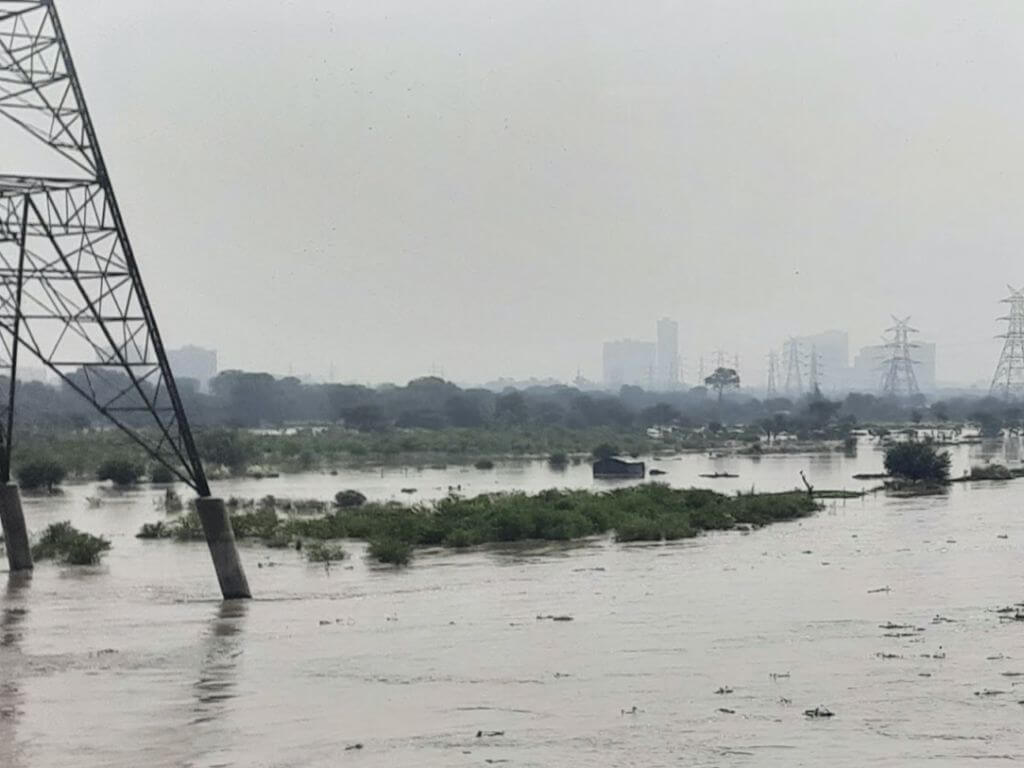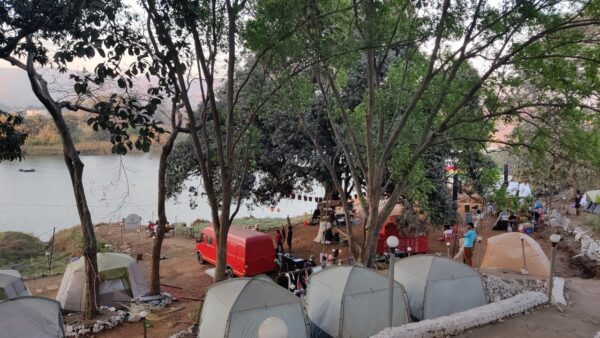Let the Yamuna flow again, is the refrain most often heard as Delhi seeks to repair its relationship with the ancient river that has nourished the city.
Despite decades of initiatives and efforts by official agencies and civil society groups, in spite of the crores of rupees committed and spent to rejuvenate the river and make it flow again, its waters that meander along the city for more than 22 kilometres and its rich floodplains all carry the adverse impact of people’s indiscriminate use – pollution, effluence, litter, construction and more.
There is no doubt that the Yamuna is in grave need of rejuvenation of its flow which must begin with the reduction of pollution in it and construction over its floodplain. But how misplaced the efforts are can be glimpsed in two ways. One, despite more than two decades of cleaning up and rejuvenating the river, it has not been brought back to its flow. Second, the effort is directed at the people with the least power who struggle to make their livelihood along the river banks.
In August 2020, as the country was still coming to terms with the Covid-19 pandemic, a team of the Delhi Development Authority (DDA) and Delhi Police resumed eviction of farmers and migrant workers from the Yamuna floodplain leaving them, who make ends meet by cultivating vegetables and plants, literally on the streets. The JCB machines minced their crops and plants, and according to them harvest on around 20 acres had been decimated and nearly 2,000 farmers were affected.
According to DDA officials, the eviction was done to clear nearly 300 acres of the Yamuna floodplains for compensatory planting of trees by the National Highways Authority of India (NHAI). When the South Asia Network of Dams, Rivers and People (SANDRP) pointed the “inhuman (act) hitting the marginal section hard,” the DDA replied that it had to be done as it has undertaken 10 projects for the rejuvenation of Yamuna floodplains by creating wetlands and planting riverine flora in close coordination with Yamuna Monitoring Committee appointed by the National Green Tribunal.
The eviction had, in a sense, legal approval. In December 2019, farmers and migrant workers on the Yamuna floodplain lost their battle in the Supreme Court for continuation of their lease. Evictions should have been fair in that every individual and agency there should have faced the JCB. However, the encroachments and dumping of malba or construction debris by organisations such as the Delhi Metro Rail Corporation, Public Works Department, Delhi Transport, and ironically the NHAI, continue to stand on the floodplain.[1]
Even those whose sensibilities were offended by the demolition-eviction did not contest it – there is broad agreement that the Yamuna and its floodplain need to be freed of activities that have polluted and harmed them – but activists like Manoj Misra, of the Yamuna Jiye Abhiyan, point out the selectivity and timing of the demolitions that hurts the poor the most.
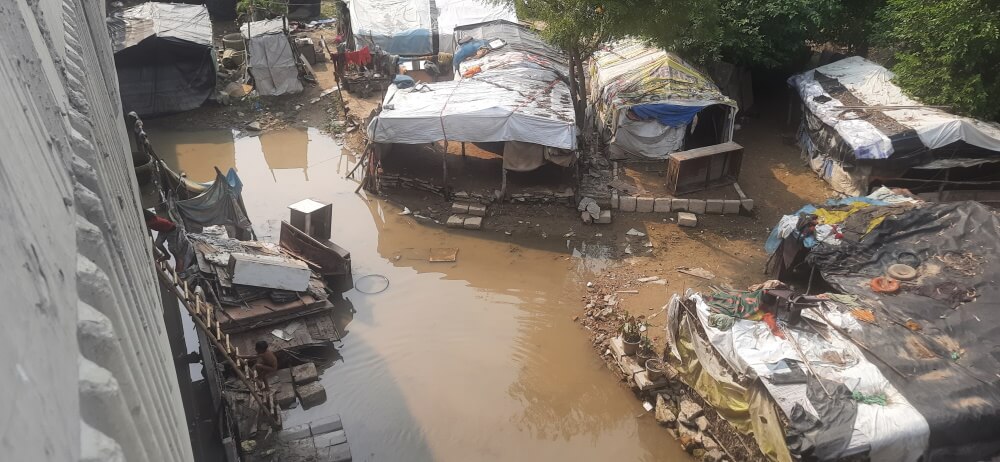
Photo: Vidheesha Kuntamalla
The familiar pollution stories
Folklore and literature described the Yamuna waters as clear blue even in the 20th century but the rapid industrialisation and urbanisation in Delhi, and the absence of nature-led urban planning, resulted in tonnes of industrial effluents and sewage being dumped into the river, making it one of the most polluted urban rivers in the world.
Delhi has drawn its sustenance from the Yamuna. About 70 per cent of the city’s drinking water needs are still met by the river. The Yamuna has not only nurtured the city’s population for centuries, witnessing its city rise and ebb, but has also framed many of its famous monuments such as the Red Fort, Humayun’s Tomb, and the area now known as Sunder Nursery. History tells us that cities were settled and abandoned several times in Delhi, but the Yamuna cradled the city as it were.
“It won’t be a mistake to say the Yamuna is Delhi’s real town planner. One major river, its 18 tributaries, and some 800 big or small tanks and lakes dotted Delhi from one end to the other. Add to this layout of the city a few thousand wells and bavdhis. This design ensured Delhi was never short of water, never had a famine, and was never ravaged by floods,” wrote eminent environmentalist Anupam Mishra in the Journal of Landscape (April-June 2012).[2]
The Yamuna enters Delhi at the Wazirabad barrage and exits in the south at the Okhla barrage. Official data shows that though only two per cent of the river flows through Delhi, between Wazirabad and Okhla, the city contributes nearly 76 per cent of the pollution load in it. The city generates nearly 3,260 million litres a day of waste water, as per the Delhi Jal Board data, but the 41 sewage treatment plants together process only 2,081 million litres a day; the rest flows into the Yamuna completely untreated.
The absence of sewage network in informal settlements or unorganised colonies compounds the problem; the treated waste from other places often gets mixed with the untreated waste at the time of release into the Yamuna. The government plans to upgrade the existing sewage treatment plants and instal sewage networks where they do not exist but this has not fully translated on the ground yet. The water in Delhi’s stretch of the Yamuna is not fit for drinking or outdoor bathing purposes and rarely meets permissible Sewage Treatment Plant discharge standards, according to this study.[3]
There is a distinct difference in the colour of Yamuna’s water during its entry and its exit from Delhi. At Wazirabad, where it enters the city, the water appears to be cleaner compared to that at Okhla when it leaves Delhi and where it almost resembles a large drain. Over the past few years, white toxic foam has been forming too. The New Delhi government’s Water Supply Board blamed industrial waste and untreated pollutants from neighbouring Haryana and Uttar Pradesh for the Yamuna’s worsening pollution, but blame game will hardly help in ecological issues which do not respect human-made borders.
The story of sewage and effluents polluting the river is a familiar one but the realisation is yet to sink in, for most people, that the Yamuna is not merely a receptacle for the waste that India’s capital produces. And its rejuvenation or restoration cannot be selective or dressed up as riverfront development, nor can it come at the cost of the poor who depend on the river.
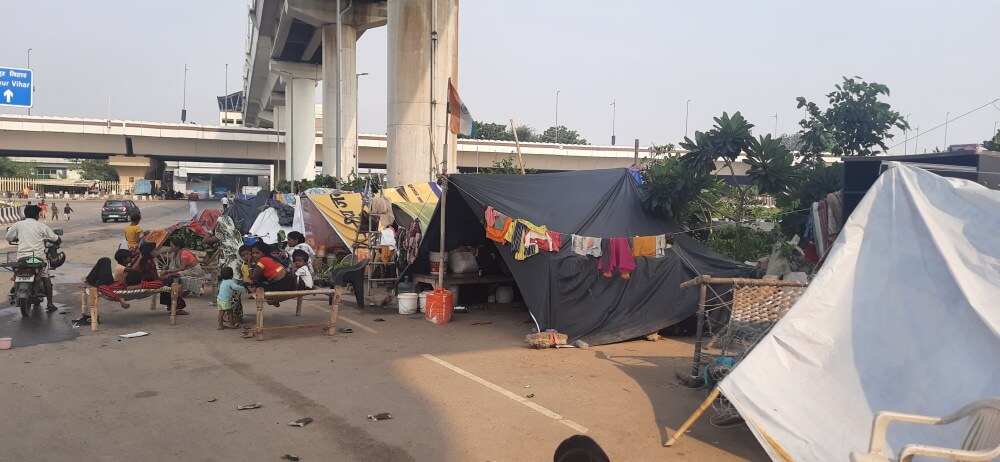
Photo: Vidheesha Kuntamalla
The people of the river
Besides farmers, those who rely on the Yamuna for their livelihood include boatmen, fishermen, priests, shopkeepers selling flowers and coconuts, and other small establishments along the river’s ghats. They have seen their revenues decline, especially during and after Covid-19, and many are exploring other avenues of income.
“There are hardly any boatmen on the Yamuna Ghat these days,” said the 38-year-old Poonam who goes by her first name only, who has been living at the Yamuna floodplain, or Yamuna Khadar, for two decades. Yamuna floodplain is the vast stretch of fertile land on the banks of the river starting from the Akshardham Temple making its way to the Delhi-Noida Highway.
Originally from Unnao in Uttar Pradesh, Poonam has seen people change their traditional profession due to water pollution and reduced footfalls. Poonam takes care of her two children while her husband grows okra (bhindi) on a small rented land in the Yamuna Khadar. They have been struggling to get a good crop for the past few years as the quality of the soil has deteriorated and they finally took to selling other farmers’ crops in the vegetable market to make their living.
The Yamuna no longer has the rohu and mostly only bears catfish and China fish which has low market value. “There are no fishermen now. The fish catch has also reduced in the past decade. Most of my friends, who were fishermen, now ride rickshaws,” said Poonam.
The effluents and sewage in the Wazirabad-Okhla stretch has affected the aquatic life too. According to the Delhi Pollution Control Committee (DPCC), the level of dissolved oxygen (DO) — the amount of oxygen available to aquatic life — is ‘nil’ at five of the eight ghats along the Yamuna in Delhi. The water to the north is rendered “dead”, with zero per cent dissolved oxygen, posing serious health hazards to people too.
The dissolved oxygen at the point at Wazirabad where the Yamuna enters Delhi is at 5.9 milligrams per litre and shows ‘nil’ at its exit in Okhla, according to the DPCC data, drawing a clear line between the city’s use of the river and the resulting pollution from it. The Central Pollution Control Board (CPCB) has also been monitoring the water quality, and its report between 2015 and 2019 showed[4] a declining trend in dissolved oxygen concentration and an increase in demand of biochemical oxygen and chemical oxygen levels. The report said that Yamuna’s water quality is “critically worse”.
Three of the main drains, of the total of 22, are the main polluters, as per the Ganga Action Plan analysis[5] – Najafgarh drain, Supplementary drain, and Shahdara drain – which regularly release toxic effluents into the river. About 45 per cent of the population in the low-lying areas lacks sewers, so sewage is released into open stormwater drains which flows into the Yamuna.
September flood renders many homeless
Delhi experienced a late monsoon rainstorm in September this year, due to the interaction of a cyclonic circulation and a low-pressure system, during which the water level in the Yamuna rose above the ‘warning’ mark. The water level at the Old Railway Bridge was 204.7 metres, a tad above the warning mark of 204.5 metres but below the danger mark of 205.33 metres. Yet, it made many people living in the low-lying areas homeless.
On the night of September 22, 2022, Kanhaiya Kumar and his family lost everything they had in the floods. Kumar, 30, a resident of the Yamuna Khadar, along with his family have been living in a makeshift plastic tent on the footpaths of the Yamuna Expressway which connects Noida to Delhi. “It has been a month since we started living on the road. Yamunaji swallowed our home overnight,” said Kumar.
Like Kumar, hundreds of families living in the low-lying areas lost their homes and moved to the roads of the city. Kumar said this happens every other year when the Yamuna overflows. Apart from this, the residents of Yamuna Khadar have to battle other problems — lack of fresh drinking water, loss of livelihood owing to the dying river and the land along the banks turning infertile.
Over the past few years, the Yamuna Khadar has been shrinking as projects such as Akshardham Temple, Commonwealth Games Village and industries have been built over the belt. The impact of Climate Change has begun to be felt in the Yamuna and its floodplain.
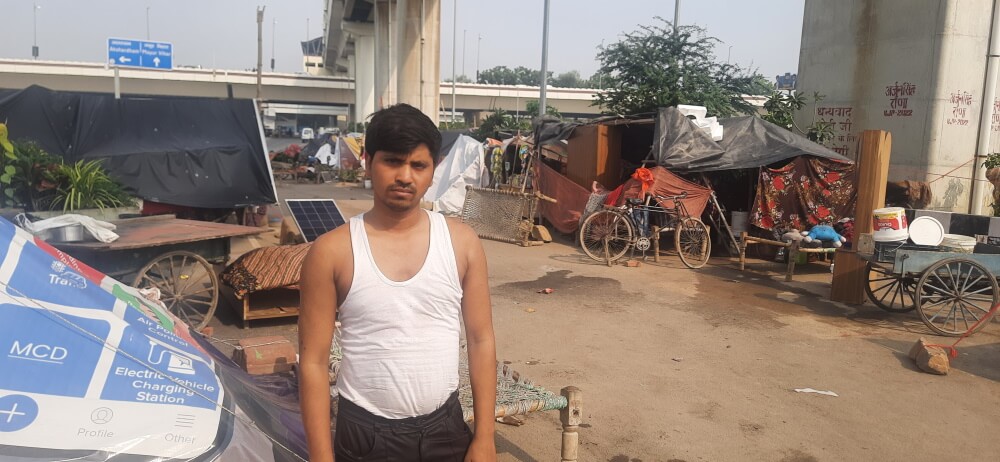
Photo: Vidheesha Kuntamalla
The rejuvenation map
Through the three long decades of the Yamuna Action Plan and other cleaning missions, the pollution is the river has become worse. The flow of the river has been tampered with as reservoirs, canals and barrages were set up to serve the needs of the city. Delhi took water from the Yamuna, and returned waste and effluents to it turning the river into a sewer pipeline as it leaves Delhi. What then can be done at this time?
For the Yamuna flow again, Manoj Misra points out that “Delhi would need to take some tough but doable calls”. Foremost among them is for the city to recognise its water privilege and downsize requirements from 220 litres per person per day to a far lower and reasonable amount, then the floodplain must be developed into underground reservoirs and fresh water lifted from the river for the city’s needs as per quota agreed with neighbouring states, go beyond the lip-service on groundwater recharge mechanisms and rainwater harvesting structures, ensure that all industries along the Yamuna are Zero Liquid Discharge (ZLD), and stop all sewage – even treated sewage – from being dumped into the river through re-use and re-cycle methods.[6]
Without such clarity of purpose and an understanding of the ecology of the river, any effort to make the Yamuna flow again can get limited to removing ‘encroachments’, especially those that are of the poor, and fiddling around with its riverfront ‘beautification’. It is note-worthy that the Parliamentary Committee on Environment and Forests found that the mission to clean Ganga and Yamuna has all but failed. “Undue investment on technical aspects such as creating sewage treatment plants to prevent pollution in the river without involving people living on the banks of the river is one of the reasons,” observes its report tabled in 2021.
“Huge barrages and hydropower plants in the upstream reaches of the river are inhibiting its flow. This, along with encroachments on the flood plains, the discharge of untreated sewage water and release of pollutants from agriculture and industry, is killing the Yamuna. Without restoring the flow of the river, there is no solution in sight,” says Bhim Singh Rawat of SANDRP.
The Yamuna will be cleaner when the sewage and effluents are either stopped from draining into it or are massively treated before being let out. In this context, the work done on the sewage treatment plants so far is important; though 17 were built they still form only 40 per cent of the required capacity and even these are not being utilised to their optimum capacity, according to the CSE report last year.[7] “This massive hardware programme, however, has not proved effective in terms of controlling pollution,” the report pointed out.
The CSE report states that the Delhi government has spent more than Rs 1,500 crore in addition to the specific allocations made by the central government schemes. However, it is not the money alone that will get the water in the Yamuna to flow again.
It is the confluence of the large project-based idea of development and the utter disregard for the basic principles of nature-led planning which have brought the Yamuna to this pass. Unless there is a mind-shift on these two critical aspects of ‘development’ and urban planning is modified from a mere land-use plan to imagining cities around the natural areas it is endowed with, especially rivers and forests, there can be no lasting solution. The focus has to go beyond eviction of old settlers and creating the Yamuna Biodiversity Park, which though commendable in itself, is hardly going to restore the flow in the river.
Although the draft Delhi Master Plan 2041 proposes “to improve the environment, with emphasis on preservation and enhancement of ecological heritage (Yamuna riverfront development, biodiversity parks)” it needs to be seen how it will be implemented. The plan stresses on the need to augment the city’s preparedness to deal with pollution, for which it proposes a blue-green policy that integrates drains (blue) with the green areas around it. However, getting the plan off the paper and operationalising it for the next 20 years remains a challenge.
Meanwhile, locals and volunteers do their little bit. Ganga Praharis, a group of motivated and trained volunteers from local communities working for biodiversity conservation and cleanliness of the Yamuna, has taken up the responsibility of cleaning the river banks; another non-profit, the Tree Craze Foundation, has also recruited over a million youths through its “Meri Yamuna, Mere Ghat” programme to aid in the clean-up drives.
However, these are little drops in the river that’s clearly demanding massive and long-term sustainable interventions. As Rajendra Singh, popularly known as ‘Jal Purush’ for his work to rejuvenate rivers, said, “Yamuna nadi ki jung mein hum sab sang hai (We are all together in the fight to make the Yamuna better) but the governments, at the centre and state, have to lead the massive effort in an imaginative way – and the most imaginative approach would be to see the Yamuna not merely as a source of water and a receptacle for waste in Delhi, but as an integral ecological section of the city which must be protected and conserved even as the city expands.
Let the Yamuna be, let the Yamuna flow again.
Vidheesha Kuntamalla is an independent journalist covering gender, politics and social justice from Telangana and New Delhi. She has written for various online publications. She was a civil engineer whose passion for journalism has now pushed her to pursue journalism full time. She also works with the Digipub News India Foundation– an initiative to create a robust and healthy digital news ecosystem.
Cover photo: Vidheesha Kuntamalla

